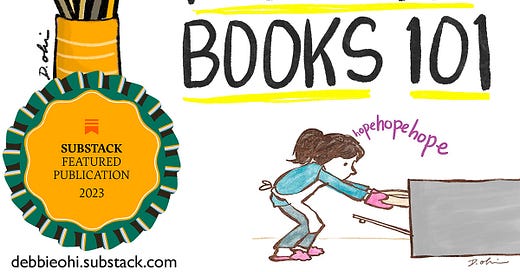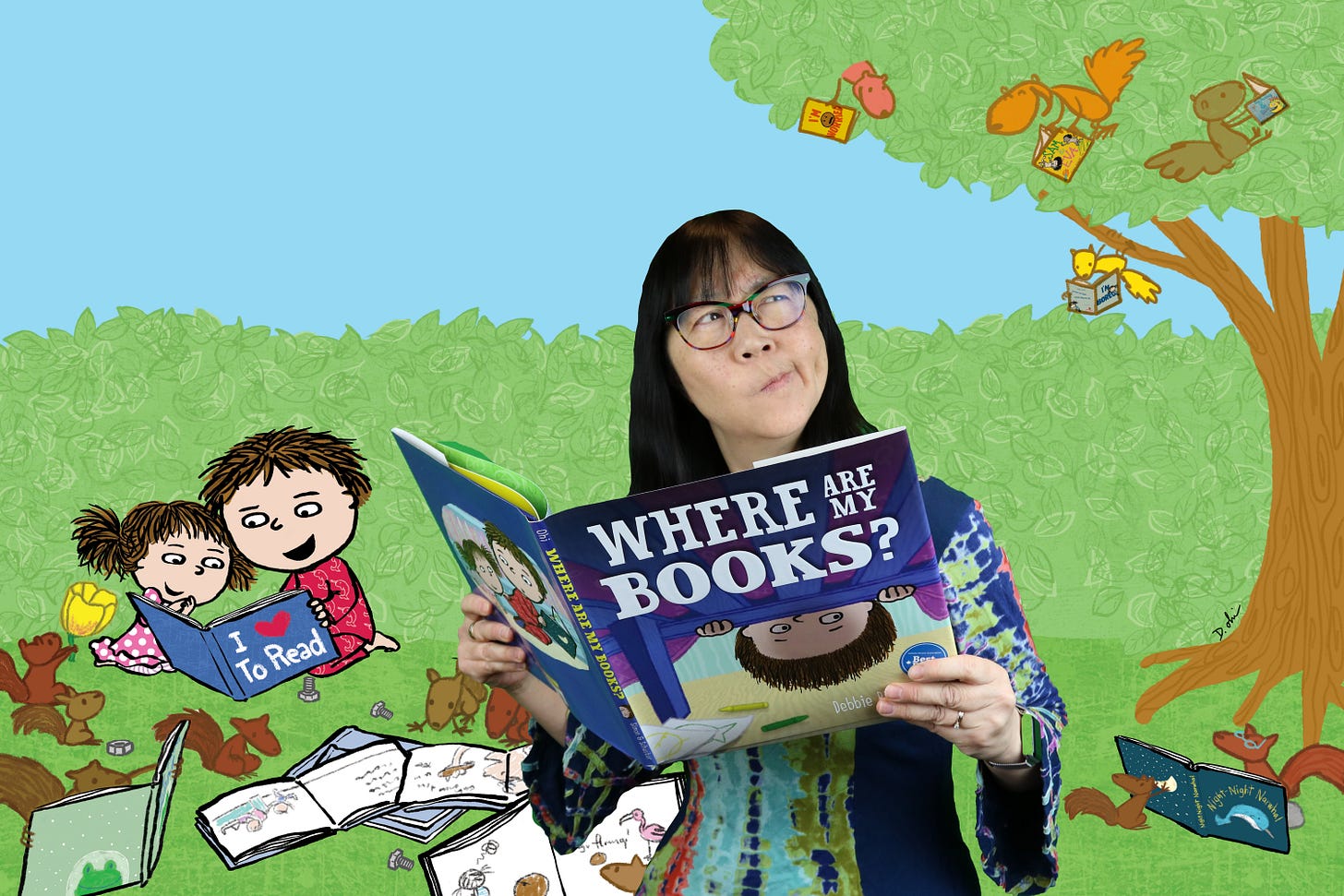Hi, I’m Debbie Ridpath Ohi! Welcome to Part 8 of my Picture Books 101 post series about writing and illustrating picture books.
This issue is geared toward picture book creators, but the advice applies to anyone working on book ideas they hope will be traditionally published.
I just came up with a GREAT picture book idea! What next?
Wonderful! Before you jump into developing your idea, however, I strongly recommend letting it sit for a while as you continue to brainstorm other ideas.
I equate this stage of story brainstorming to experimenting with a recipe for a cake. Why cake? Because cake is one of my favorite things in the world. And suppose it’s a recipe entry for a baking contest in which you can submit ONE entry.
After you have a good-sized list of story ideas, browse them all and choose the one that appeals to you the most. Maybe you’ll be so excited about this particular idea that you won’t be able to wait. Maybe you’ve already started working on expanding the story, plotting an outline and/or doodling rough sketches. Maybe you’ve just expanded the idea a wee bit, perhaps into a paragraph or a few pages of notes.
Excellent! Now put that story away and DON’T LOOK AT IT again for a while. “A while” is up to you. For me, it’s at least two weeks but sometimes several months.
In our baking analogy: it means tweaking your cake recipe and then putting that experimental cake in the oven:
RESIST THE URGE TO TAKE IT OUT OF THE OVEN BEFORE IT’S READY.
Why?
Because if you take it out too soon, it’ll look pretty much the same as when you put it in. What you want: to give it enough time to settle, to bake, to reach a state where you can taste it objectively and see whether it’s really THE cake recipe you want to submit to the contest.
Sometimes when you take it out of the oven, it’ll look like this:
Though of course we all hope for this:
But let’s get back to when your cake story looks like this:
At this point, you may realize that it’s not worth salvaging, and you may want to just toss it. Sometimes your instinct will be right.
However, there may still be SOMETHING about it that you just can’t let go of:
In that case, try experimenting some more. Maybe combine it with another idea, find a different spin, rework it in a different genre or format. Turn it upside down or reverse it, add an unexpected twist. You never know what will happen.
Then put it in the oven again to let it bake:
As before, no matter how excited you are, force yourself to work on something else and NOT take your new creation out too soon. While you’re waiting, take a look at your other recipe ideas, start experimenting for another recipe.
And so on. Ok, I’ll drop the baking analogy…you get the message, right?
Sometimes I may feel SUPER excited with a new story idea and have the urge to IMMEDIATELY dive into the writing and editing and revision process. Sometimes the first draft of the story pours out onto the paper; I love when this happens. However, I have learned to let an idea or first draft sit for a while before coming back to it. If I’m still excited about it, then I go to the next stage. After another round of writing or sketching or revising, I let it sit again and then re-evaluate.
The danger of letting yourself dive into developing a story idea too soon is that you’ll get so caught up with the “ooo shiny toy” honeymoon phase that you won’t be objective. You’re going to be pouring a lot of time and effort into this project. It’s in your best interest to take your time before you commit.
I keep several notebooks where I constantly jot down story ideas, fragments, bits of conversations and synopses for picture books, chapter books and middle grade novels. I used to use a digital notebook but I currently prefer a paper notebook where I can doodle as well as scribble ideas PLUS I like being able to physically browse earlier ideas to see if they still excite me.
More reasons to NOT rush the process:
Agents and editors have overflowing inboxes these days. During the pandemic lockdown, many people stuck at home decided that HEY, what a great opportunity to write a children’s book. And HEY, picture books hardly have any words, so they’re easy to write, right? You can help your book stand out by making it the best it can possibly be. I especially advise NOT sending out a book right after popular motivational writing challenges like NaNoWriMo and StoryStorm.
I once asked my editor at Simon & Schuster, Justin Chanda, about the biggest mistake he’s seen made by aspiring picture book writers.
“The one that I see most often, and it covers a multitude of sins, is they do not take the time to really hone their project. Writers have so many ideas they want to work on one, move on to the next, flood an editor with a bunch of projects… Thing is, picture books take time. There is craft, there is fine tuning, there is CUTTING OF TEXT. All of this takes time. A book needs to be read aloud. It needs to be tweaked and made sure that every word is there for a reason — a good reason. Rushing to get through or assuming that short = easy or quick is a recipe for disaster.
That and thinking rhyming solves everything are the biggest mistakes.”
~ Justin Chanda, VP and Publisher of Simon & Schuster children’s trade imprints
Plus, don’t forget that even if your book IS published, you’ll be expected to help promote it. Ideally, you’ll still be excited enough about your story that you’ll want to help promote it via school visits, talking with educators and librarians, social media and interviews, other venues….not just at launch but for years to come.
But what about market trends? What if I’m working about a time-sensitive topic?
There are always exceptions, of course, and no ONE right way to create a picture book.
Unless you have a VERY good reason, though, be wary of writing to market trends. If the trend is popular, chances are good that by the time your submission reaches an editor or agent, they will already be inundated by books on that topic. The trend may also be over by the time your book makes it to bookstores. Or worse, the marketplace may be so flooded by books on that particular topic that yours will get lost in the noise.
There is no ONE path to publication or publishing success, but now I’m getting off-topic and will save that for another newsletter.
My example: WHERE ARE MY BOOKS?
My first solo picture book, Where Are My Books?, began as a scribbled idea during Tara Lazar’s Picture Book Idea Month (now rebranded as Storystorm): “Squirrels steal boy’s book.” I let this sit for a while before working on the story. Three years later, it came out from Simon & Schuster Books For Young Readers! You can read more about my process here.
To sum up….
Whatever the method you use to keep track of your story ideas, I encourage you NOT to rush the process. If you can’t help yourself and are SO excited about your story idea that you are compelled to start working on it, at least let each draft sit before going back and doing revisions.
Good luck!
This is an updated version of my post for Tara Lazar’s Storystorm blog in 2017.
How do YOU brainstorm ideas? Do you use a paper or digital notebook? Have any of your ideas turned into books? Or do you find that you DON’T need to let your ideas simmer before diving in? Feel free to post your experience below!





















Great advice! And if you’re an author and illustrator, you are forced to slow down to create characters, thumbnails, story structure and arc, and of course, the dummy!
Ha ha, I love (and relate) to the idea of how tempting it is to share a half-baked book! :) So many great reminders and points here.